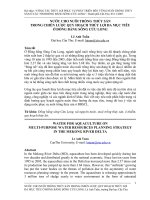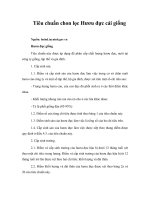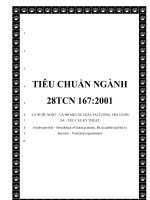Tiêu chuẩn codex cho nước mắm
Bạn đang xem bản rút gọn của tài liệu. Xem và tải ngay bản đầy đủ của tài liệu tại đây (142.5 KB, 4 trang )
STANDARD FOR FISH SAUCE
CODEX STAN 302-2011
1.
SCOPE
This standard applies to fish sauce produced by means of fermentation by mixing fish and salt and may include other
ingredients added to assist the fermentation process. The product is intended for direct consumption as a seasoning, or
condiment or ingredient for food. This standard does not apply to fish sauce produced by acid hydrolysis.
2.
DESCRIPTION
2.1
PRODUCT DEFINITION
Fish sauce is a translucent, not turbid liquid product with a salty taste and fish flavour obtained from fermentation of a
mixture of fish and salt.
2.2
PROCESS DEFINITION
The product is prepared by mixing fish with salt and is fermented in covered containers or tanks. Generally, the
fermentation process takes not less than 6 months.
Succeeding extractions may follow by adding brine to further the fermentation process in order to extract the remaining
protein, fish flavour and odour. Other ingredients may be added to assist the fermentation process.
2.3
PRESENTATION
Any presentation of the product shall be permitted provided that it meets all requirements of this standard; and is
adequately described on the label to avoid confusing or misleading the consumer.
3.
ESSENTIAL COMPOSITION AND QUALITY FACTORS
3.1
RAW MATERIAL
3.1.1
Fish
Fish sauce shall be prepared from sound and wholesome fish or parts of fish in a condition fit to be sold fresh for
human consumption.
3.1.2
Salt
Salt used shall be of food grade quality and conform to the Standard for Food Grade Salt (CODEX STAN 150-1985).
3.1.3
Water
Water for preparing brine shall be potable.
3.2
OTHER INGREDIENTS
All other ingredients used shall be of food grade quality and conform to all applicable Codex standards.
3.3
QUALITY CRITERIA
3.3.1
Organoleptic criteria shall be acceptable in terms of appearance, odour and taste as follows:
Appearance
Fish sauce must be translucent, not turbid and free from sediments except salt crystals.
Odour and taste
Fish sauce shall have an odour and taste characteristic of the product.
3.3.2 Foreign matter
This product shall be free from foreign matter.
3.4
CHEMICAL PROPERTIES
-
Total nitrogen content: not less than 10 g/l. Competent authorities may also specify a lower level of total nitrogen if it is
the preference of that country.
-
Amino acid nitrogen content: not less than 40% of total nitrogen content.
pH: between 5.0 - 6.5 typical for a traditional product; but not lower than 4.5 if ingredients are used to assist
fermentation.
-
salt: not less than 200g/l, calculated as NaCl.
Amendment 2012, 2013
CODEX STAN 302 – 2011
3.5
2
FINAL PRODUCT
The product shall meet the requirements of this Standard when lots examined in accordance with Section 11 comply
with the provisions set out in Section 10. The products shall be examined by the methods given in Section 9. The packaging for
the final product shall be free from any integrity defects, such as cracks, leakage, or loose pieces of the packaging units.
4.
FOOD ADDITIVES
Only those food additive classes listed below are technologically justified and may be used in products covered by this
Standard. Within each additive class only those food additives listed below, or referred to, may be used and only for the
functions, and within limits, specified.
Functional Class
INS No.
Additive
334; 335(i), (ii); 336(i),
Tartrates
(ii); 337
(iii)
Citrates
GMP
Malates
GMP
300
Ascorbic acid
GMP
325
Sodium lactate
GMP
260
Acetic acid
GMP
621
Monosodium glutamate
GMP
630
Inosinic acid
GMP
631
Disodium Inosine 5’monophophate
GMP
627
Disodium 5' guanylate
GMP
950
Acesulfame K
1,000 mg/kg
955
Sucralose
450 mg/kg
951
Aspartame
Colours
150c
Caramel III-Ammonia caramel
350 mg/kg
50,000
mg/kg
Emulisifiers and Stabilizers
466, 468
Acidity regulators
Flavour enhancers
Sweeteners
Preservatives
5.
330,
331
(i),
332 (i), (ii)
296, 350 (i), (ii)
351 (i), (ii)
352 (ii)
Maximum
level
200 mg/kg
(as
tartrates)
210-213
Carboxymethyl cellulose and crosslinked
GMP
carboxymethyl cellulose
Benzoates
1,000 mg/kg
200-203
Sorbates
1,000 mg/kg
CONTAMINANTS
5.1
The product covered by this Standard shall comply with the Maximum Levels of the General Standard for
Contaminants and Toxins in Food and Feed (CODEX STAN 193-1995).
5.2
Raw material fish for fish sauce shall not contain marine biotoxins (e.g. Ciguatoxin,Tetrodotoxin and PSP) in amounts
which could present a risk to human health.
5.3
Product made using aquaculture fish shall comply with the maximum residue limits for veterinary drugs established by
the CAC.
6.
HYGIENE AND HANDLING
6.1
The final product shall be free from any foreign material that poses a threat to human health.
6.2
It is recommended that the products covered by provisions of this standard be prepared and handled in accordance
with the appropriate sections of the General Principles of Food Hygiene (CAC/RCP 1-1969), Code of Practice for Fish and
Fishery Products (CAC/RCP 52-2003) and other relevant Codex Codes of Hygienic Practice and Codes of Practice.
6.3
The product should comply with any microbiological criteria established in accordance with the Principles and
Guidelines for the Establishment and Application of Microbiological Criteria Related to Foods (CAC/GL 21-1997).
6.4
The product shall not contain more than 40 mg histamine /100g of fish sauce in any sample unit tested.
7.
WEIGHTS AND MEASURES
7.1
FILL OF CONTAINERS
7.1.1
Minimum Fill
(a) The container should be well filled with fish sauce, which should occupy not less than 90% (minus any necessary
head space according to good manufacturing practices) of the water capacity of the container. The water capacity of the
container is the volume of distilled water at 20° C which the sealed container will hold when completely filled.
CODEX STAN 302 – 2011
(b)
7.1.2
3
Flexible containers should be filled as full as commercially practicable.
Classification of “Defectives”
A container that fails to meet the requirement for minimum fill of section 7.1.1 should be considered as a “defective”.
7.1.3
Lot acceptance
A lot shall be considered as meeting the requirement of section 7.1.1 when the number of “defectives” as defined in
Section 7.1.2, does not exceed the acceptance number (c) of the appropriate sampling plan with an AQL 6.5. In addition, the
average net weight or net volume shall be equal or greater than the declared net weight or net volume.
8.
LABELLING
In addition to the provisions of the General Standard for the Labelling of Prepackaged Foods (CODEX STAN 1-1985) the
following specific provisions apply:
8.1
NAME OF THE PRODUCT
The name of the product shall be “fish sauce” or other names, in accordance with the law and custom of the country in
which the product is sold, and in a manner not to mislead the consumer. The name of the product may be preceded or followed
by the common or usual name of the fish.
8.2
LABELLING OF NON-RETAIL CONTAINERS
Information on the above provisions shall be given either on the container or in accompanying documents, except that the name
of the product, lot identification, and the name and address of the manufacturer or packer, as well as storage instructions s hall
appear on the container. However, lot identification, and the name and address of the manufacturer or packer may be replaced
by an identification mark provided that such a mark is clearly identified with the accompanying document.
8.3
LABELLING OF NITROGEN CONTENT
Competent authorities may require that total nitrogen (refer to section 3.4) be declared on the fish sauce label in g/l. Competent
authorities may also require descriptors that reflect the total nitrogen level as an indicator of quality of the fish sauce.
9.
SAMPLING, EXAMINATION AND ANALYSIS
9.1
Sampling of lots for examination of the final product shall be in accordance with the General Guidelines on Sampling
(CAC/GL 50-2004). A sample unit is the individually packed product (bottle) or a 1l portion from bulk containers.
9.2
Sensory and Physical Examination Samples taken for sensory and physical examination shall be assessed by persons
trained in such examination in accordance with the Guidelines for the Sensory Evaluation of Fish and Shellfish in Laboratories
(CAC/GL 31-1999) as follows:
Complete external packaging unit examination for the presence of any integrity defects, particularly cracks or leakage
or loose pieces of the packaging units.
Examination of the product for translucence and foreign matter.
Evaluation of odour and taste.
9.3 Test methods for chemical properties
9.3.1
Determination of total nitrogen: AOAC 940.25
9.3.2
Determination of amino acid nitrogen by determining formaldehyde nitrogen (AOAC 2.066) and subtracting by
ammoniacal nitrogen (AOAC 2.065)
9.3.3
Determination of pH: AOAC 981.12 (Codex general method). The pH shall be measured in a sample of fish sauce
diluted with water to 1:10 using a pH meter. The dilution of fish sauce is necessary because of the high ionic strength in the
undiluted sauce.
9.3.4
Determination of sodium chloride: FAO 1981, Technical Paper 219 AOAC 937.13 or 976.18 or 976.19.
9.3.5
Determination of histamine: See AOAC 977.13.
10.
DEFINITION OF DEFECTIVES
The sample unit shall be considered as defective when it exhibits any of the properties defined below.
10.1
FOREIGN MATTER
The presence in the sample unit of any matter which has not been derived from salt and fish, does not pose a threat to human
health and is readily recognized without magnification or is present at a level determined by any method including magnification,
that indicates non-compliance with good manufacturing and sanitation practices.
10.2
APPEARANCE
The presence of any sediments (except NaCl crystals) and/or cloudiness.
CODEX STAN 302 – 2011
10.3
4
ODOUR
A sample unit affected by distinct objectionable odour, e.g. rotten, putrid, rancid, gamey, pungent etc.
10.4
TASTE
A sample unit affected by distinct objectionable taste, e.g. bitter, sour, metallic, taint, etc.
11.
LOT ACCEPTANCE
A lot shall be considered as meeting the requirements of this Standard when:
(i)
the total number of defective sample units as classified according to Section 10 does not exceed the acceptance
number (c) of the appropriate sampling plan (AQL-6.5).
(ii)
the essential composition and quality factors, food additives, contaminants, hygiene and handling and labelling
requirements of Sections 3, 4, 5, 6 and 8 are met.









